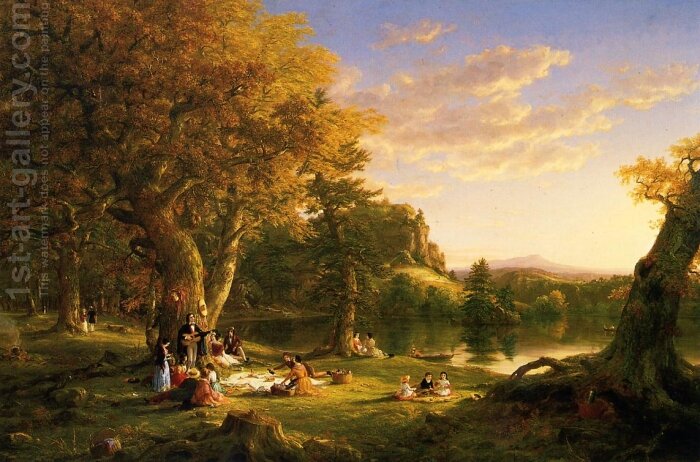Marketing Manager | Posted on | Education
Romanticism Paintings: Capturing the Essence of Emotion and Nature
0
429 Views
The art movement known as Romanticism, which emerged in the late 18th century and flourished throughout the 19th century, was a response to the societal and cultural changes brought about by the Industrial Revolution. Romanticism paintings sought to transcend the rational and ordered world of the Enlightenment, instead embracing emotion, nature, and the sublime. This article delves into the unique characteristics of Romanticism paintings, exploring the themes, techniques, and notable artists that defined this captivating art movement.
Nature's Majesty and Sublime Emotion
At the core of Romanticism paintings lies a profound reverence for nature and the power it wields over human emotions. Artists of this movement sought to depict the magnificence of untamed landscapes and the overwhelming feelings they evoked. The concept of the sublime, which embodies a sense of awe and fear in the face of nature's grandeur, was a recurring theme in these paintings. Artists such as Caspar David Friedrich, a prominent figure in German Romanticism, masterfully portrayed solitary figures in vast landscapes, underscoring the insignificance of humanity compared to the majesty of nature.

Emotion, particularly intense and often conflicting emotions, was another hallmark of Romanticism paintings. The artists of this movement believed in the importance of expressing raw human experiences, capturing moments of passion, melancholy, and even terror. Francisco Goya's haunting and macabre works, like "The Third of May 1808," exemplified the emotional intensity and empathy that characterized Romanticism art.
Escaping Reality: The Fantastical and Historical
In addition to celebrating nature and emotion, Romanticism paintings often delved into the realms of fantasy and history. Artists were drawn to the mystical, the supernatural, and the imaginative, creating dreamlike and surreal compositions. Henry Fuseli's iconic painting "The Nightmare" epitomized this aspect of Romanticism, presenting a blend of horror and fantasy that captivated viewers with its otherworldly allure.
Romantic painters were also drawn to historical subjects, often interpreting them through an emotional lens. Eugène Delacroix's "Liberty Leading the People," a depiction of the July Revolution of 1830, seamlessly merged historical events with intense emotion, emphasizing the power of collective action and the human spirit. This merging of history and emotion was a testament to the Romantic belief that art could inspire change and evoke strong sentiments.
The Power of the Individual
Romanticism paintings celebrated the individual's unique experiences and emotions, often championing the idea of the misunderstood or isolated artist. This emphasis on the individual allowed artists to explore themes of introspection and self-discovery. The self-portrait became a popular genre within Romanticism, with artists such as Théodore Géricault using it as a means to convey their inner struggles and aspirations.
J.M.W. Turner, a British Romantic landscape painter, focused on the individual's relationship with the sublime forces of nature. His swirling, atmospheric seascapes and landscapes, such as "The Slave Ship," captured the tumultuous and awe-inspiring aspects of the natural world, reflecting the internal turmoil of the human experience.
Techniques and Aesthetic Characteristics
The techniques employed by Romanticism painters were as diverse as the emotions they aimed to convey. These artists often favored rich, dramatic colors and bold contrasts to heighten the emotional impact of their works. The play of light and shadow was masterfully employed to create an ethereal atmosphere that drew viewers into the canvas. Brushwork varied from precise and detailed to loose and expressive, allowing for a range of emotional interpretations.
The aesthetic characteristics of Romanticism paintings encompassed a sense of movement, dynamism, and unpredictability. Paintings frequently featured swirling skies, turbulent seas, and untamed landscapes, reflecting the tumultuous nature of emotions and the human experience. The depiction of weather and natural phenomena, such as storms and moonlit nights, added an element of drama and heightened emotion to these works.
Notable Romanticism Artists and Their Contributions
Caspar David Friedrich (1774–1840): A leading figure in German Romanticism, Friedrich's landscapes, often featuring solitary figures facing the vastness of nature, conveyed a sense of spiritual contemplation and the sublime.
Francisco Goya (1746–1828): A Spanish artist renowned for his diverse body of work, Goya's Romanticism paintings, like "The Third of May 1808," revealed his keen observation of human suffering and his ability to evoke empathy through art.
Henry Fuseli (1741–1825): Fuseli's works, such as "The Nightmare," delved into the world of dreams, nightmares, and the supernatural, captivating audiences with their enigmatic and unsettling nature.
Eugène Delacroix (1798–1863): A prominent French Romantic painter, Delacroix's historical and allegorical works, including "Liberty Leading the People," epitomized the movement's fusion of emotion and political commentary.
Théodore Géricault (1791–1824): Géricault's emotive masterpiece "The Raft of the Medusa" conveyed the plight of human suffering in the face of a merciless sea, highlighting the Romantic fascination with tragic narratives.
Conclusion
Romanticism paintings captured the essence of human emotion, the magnificence of nature, and the power of individuality in ways that continue to resonate with audiences today. This movement, born out of a desire to break free from the constraints of reason and tradition, gave rise to a diverse array of artworks that celebrated the sublime, the historical, and the fantastical. Through their vivid colors, dynamic compositions, and intense emotions, Romanticism paintings forever altered the trajectory of art history, leaving an indelible mark on the artistic landscape.

